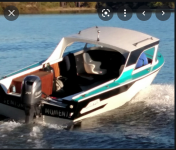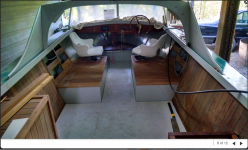Good morning everyone, I am looking for some advice if anybody has time. I bought a 1960 18ft Lonestar El Dorado to restore that will be 100% trailered and used in saltwater. It was the perfect hull style to fit on our limited-space sideyard with a little cabin and about 7ft of standup room in the back for trolling and scuba-diving gear. My previous restoration was a '76 Invader Intruder (fiberglass), and this will be my first aluminum project. I appreciate any help!
1. What size rivets are under the hull? I ordered aluminum 3/16" brazier head, 1/2" long closed rivets. I am wondering if I ordered the wrong size.
2. One the last picture, there's water leaking from this seam. I can't really find which rivet is causing the leak. Is there a special way to find it? Also in picture 8, the keel strips have holes in them I assume are factory. If water is seeping out of one, how do you find the rivet responsable?
3. In pictures 7 and 8, there's 2 pipes riveted to the hull under the seatbase. Anybody know what these are for?
4. The hull has max hp of 80hp. I was thinking about bracing the transom with extra knees and putting a 90hp 4stroke or 115 2stroke. Has anyone done this without the weight being too much?
5. Anybody ever mount a gastank under the deck on a boat similar to this?
6. Most important question that I cannot find an answer to: When I build the deck, should it be bonded to the hull at the edges to allow no saltwater to enter below deck like a fiberglass boat? My concern is if I leave a gap along the edges, saltwater can get down there from fish/wet dive gear and then I cannot hose it down when I return. Initial thought it poly or epoxy PB in the gap then a layer of 1708 (or cloth if epoxy) then paint, but then it won't be easy to remove the deck for possible future leaky rivets. What would you do?
1. What size rivets are under the hull? I ordered aluminum 3/16" brazier head, 1/2" long closed rivets. I am wondering if I ordered the wrong size.
2. One the last picture, there's water leaking from this seam. I can't really find which rivet is causing the leak. Is there a special way to find it? Also in picture 8, the keel strips have holes in them I assume are factory. If water is seeping out of one, how do you find the rivet responsable?
3. In pictures 7 and 8, there's 2 pipes riveted to the hull under the seatbase. Anybody know what these are for?
4. The hull has max hp of 80hp. I was thinking about bracing the transom with extra knees and putting a 90hp 4stroke or 115 2stroke. Has anyone done this without the weight being too much?
5. Anybody ever mount a gastank under the deck on a boat similar to this?
6. Most important question that I cannot find an answer to: When I build the deck, should it be bonded to the hull at the edges to allow no saltwater to enter below deck like a fiberglass boat? My concern is if I leave a gap along the edges, saltwater can get down there from fish/wet dive gear and then I cannot hose it down when I return. Initial thought it poly or epoxy PB in the gap then a layer of 1708 (or cloth if epoxy) then paint, but then it won't be easy to remove the deck for possible future leaky rivets. What would you do?
Attachments
-
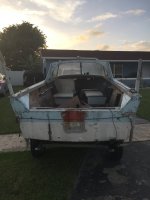 IMG_0461.JPG1,004.1 KB · Views: 19
IMG_0461.JPG1,004.1 KB · Views: 19 -
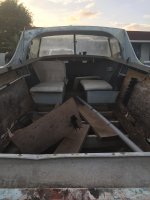 IMG_0460.JPG885.1 KB · Views: 19
IMG_0460.JPG885.1 KB · Views: 19 -
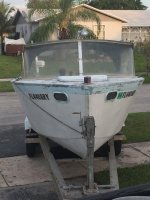 IMG_0457.JPG843.7 KB · Views: 18
IMG_0457.JPG843.7 KB · Views: 18 -
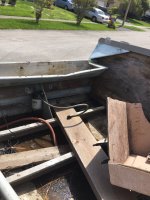 IMG_0454.JPG1.2 MB · Views: 20
IMG_0454.JPG1.2 MB · Views: 20 -
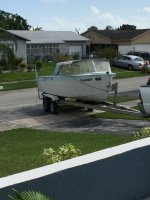 IMG_0452.JPG844.4 KB · Views: 20
IMG_0452.JPG844.4 KB · Views: 20 -
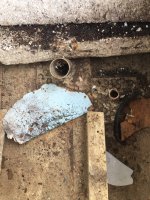 IMG_0470.JPG1.6 MB · Views: 20
IMG_0470.JPG1.6 MB · Views: 20 -
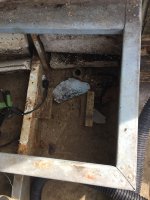 IMG_0469.JPG1.4 MB · Views: 18
IMG_0469.JPG1.4 MB · Views: 18 -
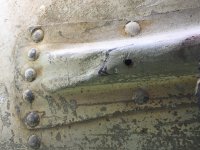 IMG_0485.JPG1.6 MB · Views: 17
IMG_0485.JPG1.6 MB · Views: 17 -
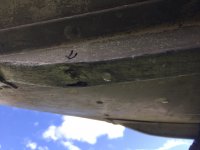 IMG_0483.JPG998.9 KB · Views: 16
IMG_0483.JPG998.9 KB · Views: 16 -
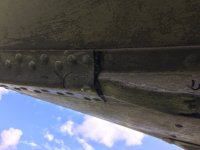 IMG_0482.JPG902.2 KB · Views: 19
IMG_0482.JPG902.2 KB · Views: 19




















